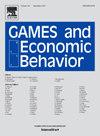选举中的利益集团信息
IF 1
3区 经济学
Q3 ECONOMICS
引用次数: 0
摘要
利益集团提供信息的方式是否系统性地使候选人产生偏见和两极分化?我考虑的是一个唐斯模型,在这个模型中,候选人不确定中间选民的偏好。多达两个利益集团,完全有偏见,观察选民的极端偏好,并向候选人发送无成本的信息。从一个利益集团开始,我展示了所有的信息均衡都是不对称的:利益集团通过向一个候选人透露粗糙的信息来“偏袒”,从而导致政策分歧。只有当利益集团拥有足够广泛的信息时,信息均衡才存在。对于对立的利益集团,这一要求是宽松的。我描述了这样一种均衡,即每个候选人对一条尾巴上的选民冲击更敏感,导致中间的政策趋同和尾巴上的分歧。利益集团的存在重新构建了政策空间,将共识的“温和”地区与“极端”地区区分开来。本文章由计算机程序翻译,如有差异,请以英文原文为准。
Interest group information in elections
Do interest groups provide information in ways that systematically bias and polarize candidates? I consider a Downsian model where candidates are uncertain about the median voter's preference. Up to two interest groups, completely biased, observe voter preferences in the extremes and send costless messages to candidates. Starting with one interest group, I show all informative equilibria are asymmetric: the interest group “plays favorites” by revealing coarse information to one candidate, causing policy divergence. Informative equilibria exist only if the interest group has sufficiently broad information. With opposing interest groups, this requirement is relaxed. I describe equilibria where each candidate is more sensitive to voter shocks in one tail, leading to policy convergence in the center and divergence in the tails. The presence of interest groups reframes the policy space, demarcating the consensus “moderate” regions from the “extremes”.
求助全文
通过发布文献求助,成功后即可免费获取论文全文。
去求助
来源期刊

Games and Economic Behavior
ECONOMICS-
CiteScore
1.90
自引率
9.10%
发文量
148
期刊介绍:
Games and Economic Behavior facilitates cross-fertilization between theories and applications of game theoretic reasoning. It consistently attracts the best quality and most creative papers in interdisciplinary studies within the social, biological, and mathematical sciences. Most readers recognize it as the leading journal in game theory. Research Areas Include: • Game theory • Economics • Political science • Biology • Computer science • Mathematics • Psychology
 求助内容:
求助内容: 应助结果提醒方式:
应助结果提醒方式:


